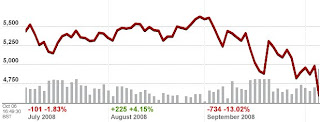
In the week of TARP’s vote $1 trillion of US equities evaporated. UK stocks fell 7.8%today, furthest than any time in 21 years. Germany’s Xetra Dax 30 fell 7.1%, the CAC 40 fell 9%. FTSE Eurofirst 300 fell 7.4%, biggest drop since Black Monday in 1987. OLondon’s biggest fallers were HBOS down 19.8%, LTSB -10.8%, RBS -20.5%, HSBC down only 4.8%. Even the 100% deposit protected banks fell: Anglo Irish Bank fell 21.6%, Allied Irish Banks -15.8%, Bank of Ireland -18.6%. The list of the biggest falling shares on FTSE Eurofirst 300 are the continent’s biggest banks. UBS fell 12.8%, Belgium’s Dexia (not big) -21.2%, Commerzbank-Dresdner lost 17.7%, Deutsche Bank down 10.8%, SocGen fell -10.1%, UniCredit fell 9%%. US indices are falling too (nearly 5% down), maybe another $0.5tn gets wiped!
Does this matter if a recovery springs from TARP’s $700bn bad bank bailout, or is it too little, too late to avert an even worse debt collapse?. Is TARP looking already like a busted flush? Have the markets decided it simply won't work? Maybe the conditions attaching (see earlier blogs) have been understood as major handicaps.
Let's look at some more of TARP’s highlights and lowlights. They are:
§ FDIC's list of 117 problem banks (assets of $78bn). The list does not include any of the large banks that have failed or been forced to merge this year.
§ Weiss Research Inc. lists 1,479 U.S. banks and 258 thrifts at risk of failure (total assets of $3.2 trillion), 41 times FDIC estimates.
The US Fed & Treasury assume debt problems may be resolved by focusing on banks with financial assets gone bad. But what if the reality is that bad debts are bad everywhere, and increasingly so if a deep and prolonged recession takes hold?
At Fannie Mae, Freddie Mac, Ginnie Mae and other government agencies, there are $5.4tn in residential mortgages 30% of these may be seriously impaired. But, as we should all know, commercial property values sink lower than residential in a property crash, and this may be true of commercial mortgages too? In the US, beyond residential mortgages, there are $2.6 trillion in commercial mortgages. Again, perhaps 30% are vulnerable to delinquency and 90 day plus defaults. And beyond all mortgages, there are another $20.4tn in consumer and corporate debts — all subject to the same risk of tripling or higher of today’s delinquency rates. Not all, not even the majority, can default however. Many mortgage holders will retain positive equity even in a 30-40% property value fall. When some businesses go bust, there may be more business for others, although there is also a systemic knock-on effect from bankruptcies.
TARP is designed to help clean up debts that have gone bad already. Future impaired loans are another matter. If the economy is revivable beginning in 2009, maybe this will not be insurmountable by better-capitalised banks, even if recession is currently still gaining momentum (half a million jobs lost so far in 6 months).
Another issue is credit derivatives exposure. Of about $182tn nominal value of outstanding derivatives contracts, $54tn are credit derivatives. The US big 4, Citibank, JPMorgan Chase (+Bear Stearns), Bank of America Merril Lynch, Wells Fargo Wachovia— are exposed to far more nominal credit risk on their derivatives than they have capital. While derivatives mostly net out there may be a large residual exposure of perhaps $1-3tn?
The Fed, after committing $200bn for Fannie & Freddie, $85bn for AIG, $25bn for the auto industry, $700bn for TARP (+ $150 billion tacked on to the plan for pork barrel tax cuts), and $100sbn in liquidity loans can Washington’s rescue measures still fall short of what’s needed to cope with $ trillions of other economic losses?
Before these bailouts, the OMB projected a 2009 federal budget deficit rise to $482bn. It would be wrong to consider the above expenditures as simply adding to this since most is money market roll-overs, swaps and loans. As argued in earlier blogs, if TARP restores confidence and works as intended there is an immediate $0.5tn gain and future profit for taxpayers. Insofar as Federal bonds are issued against securities collateral, there is also unlikely to be a crowding out effect that would push up interest rates.
Today, maybe not today, perhaps this week, we'll learn for certain if global financial markets welcome TARP or reject it with jaded, clenched teeth or death's head grins? Since TARP was signed on Friday, the Dow has plunged 2% and if it follows other markets today perhaps by another 5-6% after steep falls in Europe and Asia? Not a welcome relief! Are markets driven only by growling bears who specialise in discounting all hope as merely smoke ‘n mirrors, or can there be some hope for reviving bulls any time before some bank stocks, for some reason, somehow lead the charge instead of expecting central banks to engineer it?
No comments:
Post a Comment